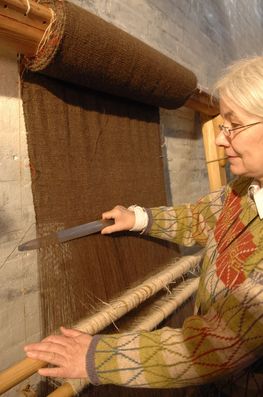Sail and rigging
The reconstruction of the Skuldelev ship’s sails has proved a particular challenge for the Viking Ship Museum, as there are but few traces preserved in the archaeological record. It is therefore necessary to draw on information from comparable finds and ethnological evidence. Below is a summary of the general questions concerning the reconstruction of sail and rigging:
The Viking ships’ square sail was, in size and shape, developed together with the individual hull size and type of ship. The central crucial factor is the elementary balance between hull, sail and rudder when sailing against the wind, i.e. sailing close-hauled.
If the sail is too broad relative to the hull and the shape of the hull, the ship seeks away from the wind – it has lee helm, and cannot tack against the wind.
If the sail is too narrow, the ship turns into the wind without the rudder being able to prevent this – it has weather helm. If this is not corrected, the ship is dangerous to sail – in fact it is useless as a sailing vessel.
If the sail is too low, the ship will sail too slowly and it will first sail properly when the wind is very strong.
If the sail, and with it the mast, is too high, the load is too great and it is necessary to reef the sail too early.
Further to all this, it is vital that the individual types of ship are ballasted and loaded correctly.
All these factors can be followed closely on Skuldelev 3, which not only has traces of the mast preserved but also has tacking holes for securing the sail forward at the rail, and sheet holes towards the stern to take the sheet. The breadth of the sail can therefore be calculated precisely.
In the successors to the Viking ships, the North European square-rigged boats, identical conditions can be traced. Here there were regulations for the dimensions of the mast, sail and rudder for the individual boat types.
There are a number of finds of rigging details, for example blocks, shroud pins, mast fragments, yard etc. from the Viking period and the Middle Ages. They show little variation in principle and execution throughout this time, and also relative to the last Nordic square-rigged boats from the early 20th century. In combination with oral tradition, it is therefore possible to produce rigging for the individual ship finds within very narrow constrains.
References
Andersen, Bent & Erik Andersen 1989: Råsejlet - Dragens Vinge. Roskilde.
Andersen, Erik 2001: The woollen sail. Research in long lenghts. Maritime Archaeology Newsletter from Roskilde 16, 22-29.
Andersen, Erik, Ole Crumlin-Pedersen, Søren Vadstrup & Max Vinner 1997: Roar Ege. Skuldelev 3 skibet som arkæologisk eksperiment. Roskilde.
